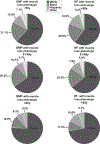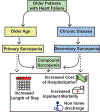Clinical impact of compound sarcopenia in hospitalized older adult patients with heart failure
- PMID: 33735939
- PMCID: PMC8273144
- DOI: 10.1111/jgs.17108
Clinical impact of compound sarcopenia in hospitalized older adult patients with heart failure
Abstract
Objectives: Skeletal muscle loss or sarcopenia is a frequent complication in heart failure (HF) and contributes to adverse clinical outcomes. We evaluated if age (primary) and chronic disease (secondary) related sarcopenia, that we refer to as compound sarcopenia, impacts clinical outcomes in hospitalized patients with HF.
Design: Cross-sectional study using hospitalized patient data.
Setting: Data from the Agency for Healthcare Research and Quality through the Healthcare Cost and Utilization Project (HCUP).
Participants: Hospitalized adult patients with a primary or secondary diagnosis of HF (n = 64,476) and a concurrent random 2% sample of general medical population (GMP; n = 322,217) stratified by age (<50 years of age [y], 51-65y, >65y) from the Nationwide Inpatient Sample (NIS) database (years 2010-2014).
Measurements: In-hospital mortality, length of stay (LoS), cost of hospitalization per admission (CoH), comorbidities and discharge disposition, with and without muscle loss phenotype, were analyzed. Muscle loss phenotype was defined using a comprehensive code set from international classification of diseases-9 (ICD-9).
Results: Muscle loss phenotype was observed in 8673 (13.5%) patients with HF compared to 5213 (1.6%) GMP across all age strata. In patients with HF, muscle loss phenotype was associated with higher mortality, LoS, and CoH. Patients with HF (>65y) and muscle loss phenotype had higher mortality (adjusted OR: 1.81; 95% CI 1.56-2.10), CoH (adjusted OR 1.48; 95% CI 1.44-1.1.52), and LoS (adjusted OR 1.40; 95% CI 1.37-1.43) compared to >65y GMP with muscle loss phenotype.
Conclusion: Muscle loss phenotype is more commonly associated with increasing age in hospitalized patients with HF. Clinical outcomes were significantly worse in patients with HF aged >65y compared to younger patients with HF and all age strata in GMP with and without a muscle loss phenotype.
Keywords: aging; clinical outcomes; heart failure; inpatient mortality; sarcopenia.
© 2021 The American Geriatrics Society.
Conflict of interest statement
Conflicts of Interest –
The other authors have no financial conflicts of interest.
Figures


Comment in
-
The other striated muscle: The role of sarcopenia in older persons with heart failure.J Am Geriatr Soc. 2021 Jul;69(7):1811-1814. doi: 10.1111/jgs.17160. Epub 2021 Apr 17. J Am Geriatr Soc. 2021. PMID: 33864385 Free PMC article. No abstract available.
Similar articles
-
Compound Sarcopenia in Hospitalized Patients with Cirrhosis Worsens Outcomes with Increasing Age.Nutrients. 2021 Feb 18;13(2):659. doi: 10.3390/nu13020659. Nutrients. 2021. PMID: 33670535 Free PMC article.
-
Skeletal muscle loss phenotype in cirrhosis: A nationwide analysis of hospitalized patients.Clin Nutr. 2020 Dec;39(12):3711-3720. doi: 10.1016/j.clnu.2020.03.032. Epub 2020 Apr 3. Clin Nutr. 2020. PMID: 32303380 Free PMC article.
-
Systemic sclerosis is associated with increased in-patient mortality in patients hospitalized for heart failure.ESC Heart Fail. 2024 Aug;11(4):1900-1910. doi: 10.1002/ehf2.14457. Epub 2024 Mar 12. ESC Heart Fail. 2024. PMID: 38472730 Free PMC article.
-
Temporal trends, prevalence, predictors, and outcomes of heart failure in patients with hypertrophic cardiomyopathy in the United States: Insights from the national inpatient sample.Curr Probl Cardiol. 2024 Aug;49(8):102665. doi: 10.1016/j.cpcardiol.2024.102665. Epub 2024 May 21. Curr Probl Cardiol. 2024. PMID: 38782196 Review.
-
COVID-19, Heart Failure Hospitalizations, and Outcomes: A Nationwide Analysis.Curr Probl Cardiol. 2023 Apr;48(4):101541. doi: 10.1016/j.cpcardiol.2022.101541. Epub 2022 Dec 16. Curr Probl Cardiol. 2023. PMID: 36529234 Free PMC article. Review.
Cited by
-
The other striated muscle: The role of sarcopenia in older persons with heart failure.J Am Geriatr Soc. 2021 Jul;69(7):1811-1814. doi: 10.1111/jgs.17160. Epub 2021 Apr 17. J Am Geriatr Soc. 2021. PMID: 33864385 Free PMC article. No abstract available.
-
Sarcopenia and Cardiovascular Diseases.Circulation. 2023 May 16;147(20):1534-1553. doi: 10.1161/CIRCULATIONAHA.123.064071. Epub 2023 May 15. Circulation. 2023. PMID: 37186680 Free PMC article. Review.
-
Sex-specific prognostic utility of the sarcopenia index in all-cause mortality risk for patients with heart failure.Front Nutr. 2025 Feb 19;12:1472596. doi: 10.3389/fnut.2025.1472596. eCollection 2025. Front Nutr. 2025. PMID: 40046757 Free PMC article.
-
Cardiovascular System is Influenced by Skeletal Muscle-derived Extracellular Vesicles, Myokines and MicroRNAs Based on Interorgan Communication: A Systematic Review.Int J Med Sci. 2025 Apr 28;22(10):2382-2397. doi: 10.7150/ijms.111775. eCollection 2025. Int J Med Sci. 2025. PMID: 40386050 Free PMC article.
-
Prognostic implication of sarcopenia diagnosed by updated Asian Working Group for Sarcopenia criteria in older patients with heart failure: Utility and limitation.J Nutr Health Aging. 2025 Jan;29(1):100434. doi: 10.1016/j.jnha.2024.100434. Epub 2024 Dec 5. J Nutr Health Aging. 2025. PMID: 39642658 Free PMC article.
References
-
- Ortman JM VV, Hogan H,. An Aging Nation: The Older Population in the United States, Current Population Reports. US Census Bureau. 2014.
-
- Antunes AC, Araujo DA, Verissimo MT, Amaral TF. Sarcopenia and hospitalisation costs in older adults: a cross-sectional study. Nutr Diet. 2017;74: 46–50. - PubMed
Publication types
MeSH terms
Grants and funding
- RO1 DK113196/NH/NIH HHS/United States
- U01 DK061732/DK/NIDDK NIH HHS/United States
- R56HL141744/NH/NIH HHS/United States
- 3U01AA026976-03S1/NH/NIH HHS/United States
- R01 AA028190/AA/NIAAA NIH HHS/United States
- R21 AA022742/AA/NIAAA NIH HHS/United States
- P50 AA024333/NH/NIH HHS/United States
- U01 AA026976/AA/NIAAA NIH HHS/United States
- K08 AA028794/AA/NIAAA NIH HHS/United States
- R21 AR 071046/NH/NIH HHS/United States
- P50 AA024333/AA/NIAAA NIH HHS/United States
- UO1 DK061732/NH/NIH HHS/United States
- K12 HL141952/NH/NIH HHS/United States
- R56 HL141744/HL/NHLBI NIH HHS/United States
- RO1 AA021890/NH/NIH HHS/United States
- U01 DK062470/DK/NIDDK NIH HHS/United States
- UO1 AA 026976/NH/NIH HHS/United States
- R01 GM119174/GM/NIGMS NIH HHS/United States
- R21 AR071046/AR/NIAMS NIH HHS/United States
- K12 HL141952/HL/NHLBI NIH HHS/United States
- 5U01DK062470-17S2/NH/NIH HHS/United States
- R01 DK083414/DK/NIDDK NIH HHS/United States
- U01 AA021890/AA/NIAAA NIH HHS/United States
- RO1 GM119174/NH/NIH HHS/United States
- R01 DK113196/DK/NIDDK NIH HHS/United States
LinkOut - more resources
Full Text Sources
Other Literature Sources
Medical
Research Materials
Miscellaneous

